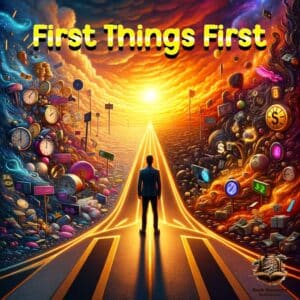
In the intricate and ever-evolving world of marketing, “Marketing: A Love Story: How to Matter to Your Customers” by Bernadette Jiwa emerges as a unique perspective on the art of marketing. Rather than being a mere process of selling a product or service, marketing, as presented in this book, is about narrating a story and forging meaningful relationships with customers. It likens the process to a love story unfolding between a brand and its audience, showcasing how stories, emotions, and connections can play a pivotal role in marketing success.
The book doesn’t merely introduce this concept but also offers tangible strategies and tactics to help brands cultivate these profound, lasting relationships with their clientele. Through a myriad of real-world examples and case studies, readers are provided insights into how these ideas can be executed in the practical realm.
In essence, “Marketing: A Love Story” serves as a guide for those wishing to delve deeper into contemporary marketing and understand how to establish customer relationships that not only endure but lead to sustained success.
How Does the Power of Storytelling Transform Modern Marketing?
In Bernadette Jiwa’s influential book, “Marketing: A Love Story: How to Matter to Your Customers,” one of the standout concepts is the transformative power of storytelling in the realm of marketing. In today’s digital age, where information is constantly at our fingertips, the sheer volume of data and facts can be overwhelming. What makes Jiwa’s approach so riveting is her emphasis on the human connection, which is often forged through stories rather than mere data points.
Storytelling, as presented in Jiwa’s work, is not a new tool but an age-old tradition that has been connecting people for centuries. It’s the warmth of a campfire tale, the pull of a well-told anecdote, and the allure of a narrative that makes us see ourselves within its folds. In the context of marketing, stories serve as a bridge, linking the brand to the customer in a way that facts alone cannot.
Consider this: facts tell, but stories sell. While a product might have excellent specifications, it’s the story behind it—the why and how of its creation, the problem it solves, the difference it makes—that captures the heart and mind of a potential customer. For instance, while one might be impressed by a shoe’s durability, it’s the tale of its crafting, the artisan’s passion, or the journey of the materials that evokes a more profound emotional response.
Furthermore, Jiwa stresses that stories are memorable. They have a way of sticking in our minds, creating a lasting impression. This is crucial in a market saturated with products and services. Brands that effectively weave narratives around their offerings often find a more engaged and loyal customer base. These stories, be they about a brand’s origin, its mission, or the challenges it has overcome, forge a deeper, more emotional bond with the audience.
In conclusion, “Marketing: A Love Story: How to Matter to Your Customers” serves as a compelling testament to the potency of storytelling in contemporary marketing. By tapping into the innate human love for narratives, brands can elevate their connection with customers, ensuring not just a transaction but a meaningful relationship.
Business & Finance Management – Book Summary (khkitab.com)
How Can Brands Foster Long-Term Relationships Over Mere Transactions?
Within the enlightening pages of “Marketing: A Love Story: How to Matter to Your Customers,” there’s a pivotal shift that Bernadette Jiwa introduces in modern marketing paradigms: moving beyond transactional interactions to cultivating enduring relationships with customers. This principle doesn’t merely signify a change in strategy; it represents a profound transformation in brand ethos and values.
In an era dominated by instant gratifications, impulse buys, and ephemeral interactions, Jiwa places an immense emphasis on the importance of building lasting relationships. It’s a notion that harks back to times when shopkeepers knew their customers by name, understood their preferences, and catered to their specific needs. While the digital age might seem distant from this personalized touch, the underlying sentiment remains more relevant than ever.
Brands that prioritize relationships over transactions understand that each customer interaction is an opportunity to deepen that bond, not just make a sale. It’s about listening to the customer, understanding their aspirations, their challenges, and aligning the brand’s narrative to resonate with these insights. When customers feel seen, heard, and valued, their loyalty to the brand transcends any single purchase.
Moreover, Jiwa underscores the financial wisdom behind this approach. Acquiring a new customer is often more costly than retaining an existing one. By nurturing relationships and consistently delivering value, brands can not only ensure repeat business but also turn their customers into advocates, amplifying their reach and impact.
In essence, “Marketing: A Love Story: How to Matter to Your Customers” challenges brands to think long-term, to prioritize connection over conversion, and to understand that in the grand tapestry of business, it’s the threads of genuine relationships that hold everything together. The future of successful marketing isn’t just about selling; it’s about connecting, caring, and creating experiences that matter.
Our Facebook Page – Book Summary
Why is Empathy the Cornerstone of Effective Marketing?
Within “Marketing: A Love Story: How to Matter to Your Customers”, a profound takeaway revolves around the core essence of empathy in marketing. Empathy isn’t just about understanding the customer’s needs, desires, and aspirations—it’s about genuinely feeling and resonating with them, crafting solutions that directly address these emotions and desires.
In the noisy digital age where customers are bombarded with a plethora of advertisements, products, and services, standing out is a daunting task. However, Bernadette Jiwa argues that the brands which truly resonate are the ones that demonstrate an authentic understanding of their audience. It’s not about selling a product, but rather addressing a pain point, fulfilling a desire, or helping the customer achieve an aspiration.
Empathy goes beyond mere market research. It dives deep into human psychology, recognizing the inherent desire for validation, the need for solutions that simplify life, and the pursuit of happiness and fulfillment. By aligning marketing strategies with these deeply-rooted human desires, brands can foster a meaningful connection, elevating themselves from mere vendors to trusted partners.
Furthermore, empathetic marketing recognizes that customers are not homogenous. Different segments have different needs, aspirations, and pain points. Tailoring messaging and solutions to these specific segments, with genuine empathy, can result in a more engaged, loyal, and satisfied customer base.
In essence, “Marketing: A Love Story: How to Matter to Your Customers” reiterates the indispensable nature of empathy in crafting marketing narratives. By genuinely understanding and connecting with the customers, brands can craft more effective, meaningful, and impactful campaigns, resulting in not only better sales but also lasting brand loyalty and trust.
How Can Modern Marketing Metrics Redefine Brand Engagement and Satisfaction?
In “Marketing: A Love Story: How to Matter to Your Customers”, there’s an intriguing discussion about the evolution of marketing metrics. Traditional metrics, such as sales figures, click-through rates, and impressions, while important, don’t always capture the essence of true brand engagement and customer satisfaction.
Today’s fast-paced digital environment demands a more holistic approach. Customers are no longer passive recipients of marketing messages; they’re actively engaging with brands, sharing experiences, and influencing others. This shift necessitates a fresh perspective on how we measure success.
Bernadette Jiwa suggests that genuine brand engagement can’t be distilled into mere numbers. Instead, it’s about understanding the stories behind these numbers. Why did a customer recommend a product? What emotions did an advertisement evoke? How did a brand’s message align with a customer’s personal values or aspirations?
Modern marketing metrics, therefore, should focus on qualitative insights rather than just quantitative data. Surveys that gauge customer sentiment, feedback loops that capture authentic customer voices, and social media listening tools that discern genuine brand perceptions are all crucial in this new landscape. These metrics can provide invaluable insights into how customers truly feel about a brand, transcending traditional numerical data.
Furthermore, to gauge real customer satisfaction, businesses must look beyond mere product or service satisfaction. Are customers proud to associate with the brand? Do they feel understood and valued? These questions provide a more rounded view of satisfaction, emphasizing the emotional and relational aspects of brand interactions.
In essence, “Marketing: A Love Story: How to Matter to Your Customers” emphasizes that redefining success in marketing requires moving beyond conventional metrics. In the modern era, understanding the heart and soul of customers, capturing their sentiments, and aligning with their aspirations are pivotal. Brands that recognize and adapt to this shift will not only succeed in numbers but also in building meaningful and lasting relationships with their customers.
How Does Genuine Trust in Marketing Translate to Customer Loyalty?
In the insightful book “Marketing: A Love Story: How to Matter to Your Customers,” there’s a pivotal chapter that delves deeply into the integral role of trust and loyalty in the marketing realm. Understanding these dynamics is essential in today’s competitive business landscape.
At its core, marketing is not just about selling products or services but about building meaningful relationships. And like any good relationship, trust is the foundation. The book underscores the fact that modern consumers are increasingly discerning. With a plethora of choices available and an unprecedented access to information, customers can quickly discern between genuine brand messages and mere sales pitches.
To establish trust, brands need to go beyond catchy slogans or flashy advertisements. Authenticity, transparency, and consistency are the three pillars that uphold trust. The book highlights several case studies where brands have successfully managed to imbue these values, creating not just transient customers but loyal advocates.
Loyalty, as “Marketing: A Love Story” aptly puts it, is the reward brands receive for consistently honoring their promise to customers. It’s not about creating one-off experiences but ensuring a seamless, positive interaction at every touchpoint. Loyal customers not only bring repeat business but become ambassadors for the brand, offering word-of-mouth recommendations that are far more potent than any advertisement.
Moreover, the book emphasizes that trust is fragile. A single misstep, like a misjudged campaign or a lapse in product quality, can erode years of goodwill. Hence, the constant vigilance in maintaining standards and openly addressing any issues is key.
In essence, “Marketing: A Love Story” offers a transformative perspective on marketing. In a world saturated with brands vying for attention, genuine trust and loyalty become the distinguishing factors for success. Brands that embrace these principles, that truly understand and prioritize their customers’ needs, are the ones that stand the test of time.
Why is the Brand Narrative More Powerful than the Product Alone?
In “Marketing: A Love Story: How to Matter to Your Customers,” a profound insight emerges about the transformative power of storytelling in the marketing realm. Contrary to traditional beliefs, it’s not just the product or its features that captivate a customer’s interest, but the story behind it.
Modern consumers are inundated with countless product options, with many sharing similar features and benefits. So, what differentiates one product from another in such a saturated market? The book underscores the importance of the narrative. A compelling story can elicit emotions, build connections, and establish trust, while also instilling a sense of purpose and belonging.
Take, for instance, the rise of brands that emphasize sustainability. While their products might be similar to others, they stand out because of the stories they tell about saving the planet, ethical sourcing, and giving back to communities. These narratives don’t just communicate the value of the product; they resonate with the values of the consumers, creating a deeper bond.
Furthermore, the book discusses the neuroscience behind storytelling. Our brains are hardwired to understand and retain stories. A well-crafted narrative not only keeps us engaged but also facilitates memory retention, making it easier for customers to remember a brand and its message.
Another pivotal point emphasized is that consumers nowadays don’t just buy a product; they buy into a lifestyle, a philosophy, or even a movement. This shift from transactional to experiential purchasing highlights the power of a brand’s story. The narrative encapsulates a brand’s essence, its values, and its promise to the consumers.
However, “Marketing: A Love Story” also warns against insincere storytelling. It’s not about fabricating tales but authentically representing the brand’s journey, challenges, and aspirations. Authenticity is crucial, as modern consumers are savvy and can easily discern between genuine narratives and marketing ploys.
In conclusion, while a product’s quality and features remain essential, it’s the story behind the product that often leaves a lasting impact. As “Marketing: A Love Story” so eloquently conveys, in a world where products might be transient, stories endure, bridge gaps, and form lasting connections. Brands that recognize this and weave powerful narratives around their offerings don’t just market; they matter.
Why Are Traditional Advertising Methods Struggling in Today’s Marketplace?
In “Marketing: A Love Story: How to Matter to Your Customers,” the challenges of traditional advertising are dissected and explored, highlighting the growing disconnect between old-school methods and today’s empowered consumers. With the digital revolution, the way we consume information, products, and even services has drastically changed, which, in turn, demands a fresh approach to marketing.
- Audience Fragmentation: Gone are the days when a prime-time television ad would reach the majority of the audience. Today, with countless channels, streaming platforms, and digital distractions, capturing a significant audience chunk through traditional means has become a challenge.
- Distrust in Brands: Traditional advertising often pushed products with a one-way communication model. Modern consumers, informed and connected, prefer a two-way dialogue. They are wary of overt sales pitches and more responsive to genuine, transparent brand messages.
- Demand for Personalization: The contemporary consumer craves tailored experiences. They expect brands to understand their preferences and cater to them. Traditional advertising, which is often broad and generalized, fails to hit the mark in this respect.
- Digital Dominance: With the internet’s pervasive nature, consumers now have a world of information at their fingertips. They can easily research products, read reviews, and get peer recommendations. This dynamic has diminished the unilateral influence of traditional advertisements.
- Desire for Authentic Stories: As highlighted throughout “Marketing: A Love Story,” today’s consumers are driven more by narratives and what a brand stands for than by mere product features. Old-school advertising often lacks this depth and connection.
- Cost-effectiveness: Digital marketing campaigns, particularly organic ones, can offer a better return on investment (ROI) compared to high-cost traditional advertising avenues. Brands are now questioning the efficacy of spending vast sums on methods with dwindling impact.
- Evolving Metrics of Success: Success in modern marketing isn’t just about reach but engagement. Brands seek a deep connection, fostering loyalty and community. Traditional advertising methods, being more transactional, often fall short in building lasting relationships.
In conclusion, while traditional advertising isn’t entirely obsolete, its challenges in the contemporary marketplace are evident. “Marketing: A Love Story” underscores the need for brands to evolve, emphasizing authentic narratives, two-way dialogues, and genuine customer engagement over mere exposure. As the market dynamics shift, so must the strategies to remain relevant and impactful.
How Can Story-Driven Approaches Revolutionize Modern Marketing Strategies?
In “Marketing: A Love Story: How to Matter to Your Customers,” the author delves deep into the transformational power of story-driven marketing. As consumers grow more skeptical of traditional advertising tactics, brands are now required to connect on a more personal, emotional level. Here are some pivotal insights from the book on modern marketing strategies that leverage the power of storytelling:
- Humanizing Brands: People relate to stories because they appeal to our emotions and our innate human desire to connect. Brands should aim to present themselves not as faceless corporations but as entities with values, emotions, and narratives. This strategy creates a sense of relatability and trust.
- Embracing Authenticity: Today’s consumers are well-informed and can easily discern between authentic messaging and forced narratives. Authentic stories resonate more, leading to deeper brand loyalty. Highlighting genuine customer testimonials or sharing the origins of a brand can be potent tools in this context.
- Educate, Don’t Just Advertise: Instead of merely focusing on product features, successful story-driven marketing educates the audience. Whether it’s the journey of how a product is made or the values the brand stands for, enlightening narratives often lead to better engagement.
- Interactive Storytelling: Leveraging interactive platforms like social media allows brands to co-create stories with their audience. It’s not just about telling stories but about making the audience a part of them. For instance, brands can initiate campaigns where customers share their personal experiences related to the product.
- Incorporate Visual Narratives: In an age where video content reigns supreme, visual storytelling can dramatically amplify a brand’s message. Infographics, animated videos, or even virtual reality experiences can make narratives more immersive and memorable.
- Leveraging User-Generated Content: Real stories from real customers can often be more compelling than any crafted campaign. Encouraging and curating user-generated content can provide brands with authentic narratives that resonate with potential customers.
- Embrace Vulnerability: Not all stories need to highlight successes. Sharing challenges, failures, and subsequent learnings can make a brand more relatable. It underscores the brand’s commitment to growth and transparency.
- Case Studies as Narratives: A detailed exploration of how a product or service transformed a customer’s life or business can serve as compelling evidence of its value. Case studies, presented as stories, can effectively bridge the gap between abstract benefits and tangible results.
In conclusion, “Marketing: A Love Story: How to Matter to Your Customers” offers a refreshing perspective on the evolving landscape of modern marketing. By pivoting to story-driven strategies, brands can not only engage their audience more effectively but also forge lasting, meaningful connections.
Why is a Customer-Centric Approach Essential in Modern Marketing?
In the insightful book “Marketing: A Love Story: How to Matter to Your Customers”, there’s an emphasis on the shift from traditional product-centric marketing towards a more customer-centric approach. This approach prioritizes the values, needs, and experiences of customers over purely business-driven agendas. Let’s delve deeper into the fundamental concepts explored in the book regarding this:
- Emotional Connection: Modern consumers desire more than just a product or service; they yearn for brands that understand and cater to their emotions. Building an emotional connection ensures brand loyalty, as customers feel that the brand genuinely cares about them.
- Understanding Customer Journeys: A customer-centric approach requires a deep understanding of the customer’s journey. From the first interaction to post-purchase support, every touchpoint should be optimized to meet the customer’s expectations and enhance their overall experience.
- Feedback is Gold: Listening to customer feedback and acting upon it not only addresses immediate concerns but also indicates that the brand values its customers’ opinions. This fosters trust and strengthens the customer-brand relationship.
- Personalization: With the abundance of data available, brands can now offer personalized experiences tailored to individual customer preferences. This level of personalization enhances the customer’s experience and makes them feel unique and valued.
- Educate, Don’t Just Sell: Providing valuable content that educates or informs the customer about relevant topics, rather than just pushing for sales, establishes the brand as a helpful and trusted resource.
- Building Communities: Engaging customers by building communities around the brand allows for direct interaction and engagement. It not only provides a platform for customers to voice their opinions but also fosters a sense of belonging.
- Long-term Relationships: A customer-centric approach aims at building long-term relationships rather than just one-time sales. By ensuring consistent quality and support, brands can ensure that customers keep coming back.
- Ethical Considerations: Modern consumers are more socially and environmentally conscious. Brands that prioritize ethical considerations in line with customer values are more likely to build a loyal customer base.
In essence, “Marketing: A Love Story: How to Matter to Your Customers” underscores the importance of pivoting from a solely product-driven approach to one that truly understands and values the customer. By adopting a customer-centric approach, brands can not only enhance their reputation but also ensure sustainable growth in today’s competitive marketplace.
Why is Building a Brand for the Long-Term Essential for Sustainable Success?
In “Marketing: A Love Story: How to Matter to Your Customers,” the importance of cultivating a brand with a long-term vision is extensively highlighted. As the market continuously evolves and customer preferences shift, having a fleeting, transaction-based approach to marketing can render a brand obsolete. Instead, building a brand with a vision that spans years, if not decades, is crucial. Let’s delve into the main ideas surrounding this concept as explored in the book:
- Beyond Immediate Sales: While short-term sales are essential, a brand’s longevity is determined by its capability to establish deep, meaningful connections with its audience. This involves thinking beyond immediate revenue and focusing on creating lasting relationships.
- Evolution with the Market: A brand built with a long-term vision is more adaptable. Such a brand is proactive in understanding and predicting market shifts, ensuring it evolves alongside its customer base.
- Customer Loyalty: Brands that invest in the long-term tend to have a dedicated customer base. These customers become brand advocates, championing the brand organically, leading to authentic word-of-mouth marketing.
- Consistent Brand Image: A long-term vision enables brands to have a consistent image and message. This consistency builds trust among consumers as they know what to expect from the brand, irrespective of the evolving landscape.
- Investment in Quality: Brands aiming for longevity prioritize quality over quick wins. Whether it’s the product quality or the quality of customer service, such an approach guarantees repeat business and referrals.
- Future-oriented Strategies: A long-term perspective pushes brands to implement sustainable practices, be it sourcing ethically, reducing carbon footprints, or creating a positive impact in the communities they operate.
- Emotional Connection: As indicated in the book, marketing is akin to a love story. Brands with a vision for the future focus on building an emotional narrative, making them more relatable and memorable.
- Value-driven Approach: Longevity in the market is often linked to a brand’s core values. Brands that stand for something and communicate those values consistently tend to resonate more with consumers.
In summary, “Marketing: A Love Story: How to Matter to Your Customers” emphasizes the transformative power of a long-term vision in brand-building. It’s not just about being relevant today but ensuring that the brand remains significant, impactful, and loved by its customers for the years to come. This longevity ensures sustainable success in an ever-competitive marketplace.



[…] Marketing: A Love Story – Building Strong Customer Relationships for Success […]